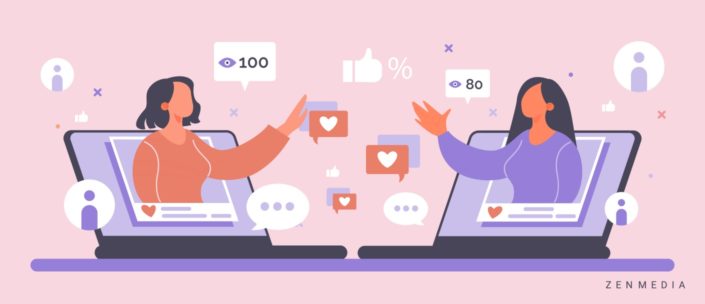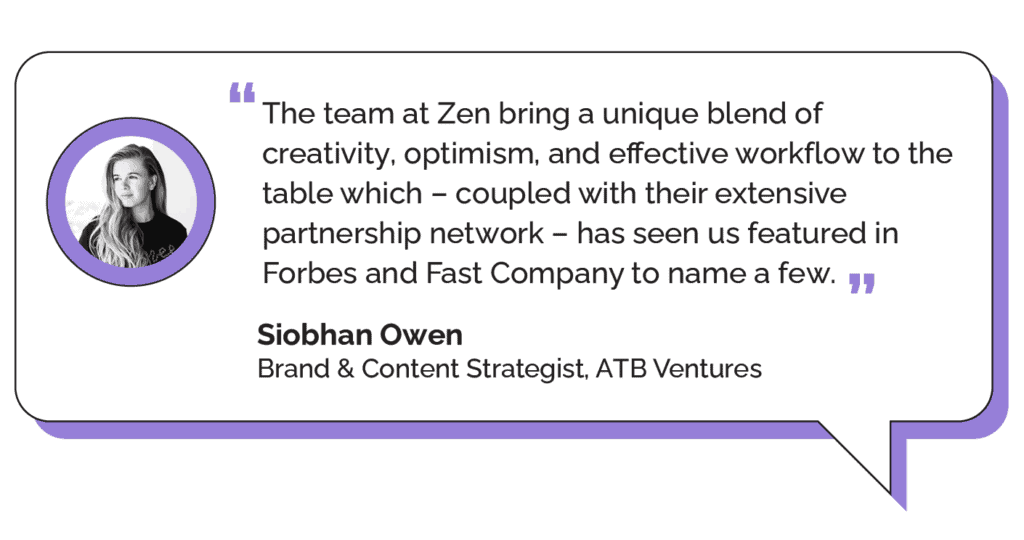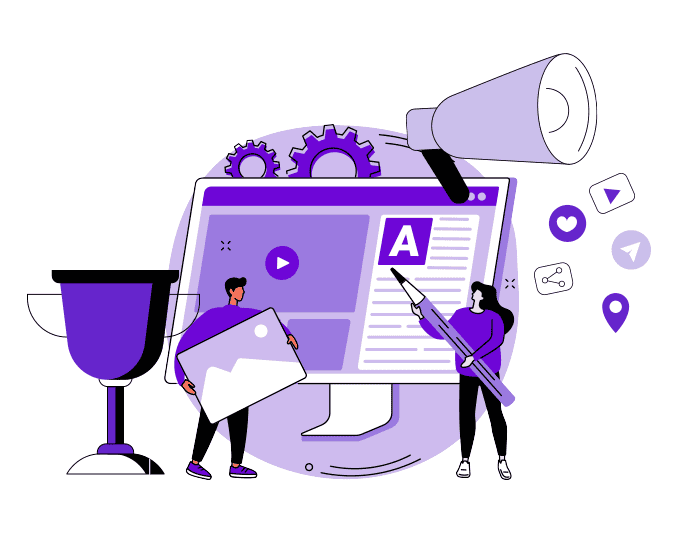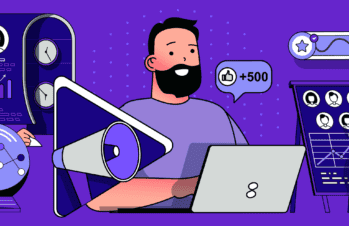You probably know that a good digital marketing strategy should include paid, owned, rented, and earned media if it’s going to be really effective. This applies to both B2C and B2B marketing strategies.
In this piece, we’re going to focus on that final one—earned media—and how our earned media guide can help you revamp your brand’s approach to attracting customers. But before we dive in, let’s define each term and explain how these four elements work together.
How to make the most of earned media:
— Shama Hyder (@Shama) April 30, 2021
👉🏼 put the media outlet logo on your website
👉🏼 share influencer endorsements
👉🏼 use earned media in paid ads
👉🏼 put earned media in newsletters
👉🏼 encourage employees to share
Paid, owned, and earned media: What do they mean?
Paid media. Paid media is fairly straightforward. It means media (or advertising) that you pay for—social ads, print advertising, paid partnerships, PPC campaigns, etc.
Owned media. Owned media consists of the channels your brand controls, like your brand’s website, email newsletters, blog, etc., in addition to content you produce on those platforms, such as white papers, videos, and infographics.
Rented media. Rented media consists of your own content hosted on someone else’s platform. Social media is a great example of this.
The thing with both paid and owned media is that your brand is the one calling the shots. For example, you decide how much to spend on your paid ads, and how to target them. You create blog posts and share them across your social channels. And you decide what information to display on your website. This is even true for rented media, however, the fact that someone else technically owns social media platforms means you lose some control over your content.
With earned media, however, your brand isn’t in charge. So how do you get earned media if you are a B2B or B2C brand? Well, it’s just that: earned. It’s what third parties, like media outlets, influencers, and your customers say about your brand—not because they’re paid to, but because they are inspired to.
Now, it’s easy to fall into the trap of thinking that if your brand offers a quality product or service and regularly engages with fans and other brands online, earned media will simply appear. That’s possible—but never a given. Earning that coverage takes work and, sometimes, a lot more work than your paid and owned coverage.
But here’s the good news: There are a lot of marketing tactics you can use to your advantage to expand your brand mindshare and then make the most of whatever earned media you attract.
Here’s our complete how-to guide for earned media.
But first: why does earned media matter?
While paid and owned media are still pivotal pieces of your marketing strategy, earned media is essential because it doesn’t come from your brand—and connected B2B and B2C audiences are therefore more likely to trust it.
There’s also an SEO value to earned media. Since Google rewards fresh content, earned media from third parties—in other words, fresh content about your brand in the form of articles, posts, reviews, etc.—can boost your “freshness” score and push your brand up higher in search rankings.
Related post: 51 Out-of-the-Box Strategies for B2B SEO
12 Earned Media Tactics to Secure Brand Coverage
1. Prepare a solid earned media strategy
Like any marketing effort, planning out a defined strategy will help you achieve your goals in a much more efficient and measurable way. Here’s what to do:
- Define your goals. Are you trying to generate more brand awareness in general? Push a particular product or service? Reach a new target demographic?
- Figure out who you’re targeting. Get very specific about the target audience or demographic you’re trying to influence. Create personas that tell you what they want, who they are, what they value, where they go to search for information, etc.
- Research the content that is performing the best with your target audience. For example, for B2B campaigns, it’s smart to spend time learning what kind of b2b content your audience is consuming. Tools like BuzzSumo can help with this, although some simple Google searching can work as well.
- Research the outlets and influencers you want to connect with. Remember, if you’re paying someone to write about your brand, it’s not earned media. Instead, you want to find publications, review sites, influencers, and customers who would likely partner with you because they like your brand—perhaps they align with your brand values or need your company’s expertise.
- Reach out to those outlets and influencers with pitches. When you know which outlets and influencers you want to target, you can craft pitches designed specifically for them. Specificity is essential—you don’t want to pitch a science and tech magazine a profile story on your CEO.
- Share your earned media on your own social channels. Once you’ve achieved that earned media coverage, make sure you capitalize on it by sharing it across your social platforms with employees, investors, existing customers, and others who have a stake in your business.
Related post: 6 Reasons Why Social Media Marketing Matters for B2B
2. Create more earned media
There are several ways you can start generating more earned media. Identify brand ambassadors on your social channels and up your engagement with them. Brand ambassadors are simply individuals who prefer and value your brand and who, most importantly, are vocal about that online. This approach works for B2B and B2C brands.
For example, for B2C, Facebook fans who regularly like and share your posts with their audiences, X (formerly Twitter) followers who repost your content, and bloggers who’ve mentioned your products in their posts are all potential brand ambassadors. To help cultivate these fans, make sure you engage with them regularly. Thank them for their support. Find out if they have a blog or website of their own. Do what you can to show your appreciation for them, whether that means sending them a coupon or sharing one of their posts on your brand’s social channel.
3. Get in touch with journalists
Reporters and journalists always need quotes from industry experts. Search for reporters who cover topics that your brand’s leadership can speak to, and pitch them a story idea. Another good tool is HARO, or Help a Reporter Out—this site connects sources with journalists who need their expertise.
Related post: Strategic Public Relations: Planning, Process, and Execution
4. Cultivate influencers
Influencer marketing requires ongoing efforts, as effective influencer campaigns have to be built around a mutually beneficial relationship with your brand.
If you’re reaching out to someone you’ve never contacted before, make sure to do your research beforehand. Figure out what kind of content they typically produce, what their followers respond to, and what topics are important to them. Then, send them a pitch that reflects that knowledge and familiarity. The easier it is for them to say yes to a partnership without having to make lots of changes, the better.
And don’t forget to cultivate your existing influencer relationships as well. Show your appreciation for influencers you’ve partnered with in the past by actively engaging with their content and sharing it with your audience when appropriate. It’s best to think about B2B influencer marketing as a long-term strategy.
5. Participate in conferences and industry trade shows
While so much marketing happens online these days, it’s important not to neglect offline opportunities to network.
Face-to-face meetings with fellow brands, as well as bloggers, journalists, and industry experts who attend conferences and trade shows, can be highly effective in securing earned media. This is especially true because so many events now encourage real-time social media coverage from attendees, creating unique hashtags for participants to use on all their posts.
It’s the perfect opportunity to earn a few social media mentions from colleagues and give a few to brands you admire.
6. Host events and experiences for your customers
Experiential marketing—or digital campaigns that are driven by an event, gathering, or experience shared by customers and a brand—is an incredibly effective way to connect with your audience and boost your earned media.
According to research by event marketing platform Splash, 47% of event marketers say in-person events yield the largest ROI. Additionally, 84% of events cater to current customers while 2 in 5 cater to prospective customers. This proves just how successful experiential marketing is with current customers, but leaves more room to welcome potential customers into the fold.
What’s more, significant branded events often earn coverage by traditional media outlets, like newspapers and magazines, and online outlets like blogs and localized websites (like Eater or Thrillist).
You can also encourage attendees to share posts and images of your event with their own social networks by creating an event-specific hashtag and making sure your social media manager reposts likes, and shares attendee posts.
7. Get the most mileage out of your earned media
Don’t forget that earned media is something you can reuse and repurpose throughout your owned media channels.
Create a blog post roundup highlighting some posts about your recent event pulled from X or Instagram. Include customer testimonials in your next webinar. Distribute influencer quotes about your product to review sites.
There are plenty of possibilities to increase your brand’s earned media.
Want to learn more about upping your earned media game? Read “How We Earned Dippin’ Dots More Coverage Than a Super Bowl Ad…Without Spending a Dime on Paid Advertising.”
8. Encourage product reviews
Reviews about your products or services can help increase traffic to your site and improve conversions. They can even influence customer behavior. In fact, according to a recent study, 91% of consumers trust reviews when making purchasing decisions. However, there are risks associated with product reviews, too. A negative review could hurt your reputation, especially if it goes viral.
A good way to avoid such problems is to make sure that your reviews are authentic and unbiased. Make sure that they are written by real people, and don’t include false information like fake names or email addresses. Also, ensure that they are posted in places where they can reach many eyes, including social networks, online forums, and blogs.
Another way to leverage reviews is to publish them yourself. You can do this either on your own website or via third-party sites like Amazon, Facebook, Yelp, and TripAdvisor.
9. Leverage word-of-mouth recommendations
Word-of-mouth recommendations are considered to be one of the most powerful forms of earned media. After all, what is influencer marketing if not a digital version of word-of-mouth marketing where recommendations are made based on an actual person’s experience with a brand, product, or service?
What makes it so successful? There are no barriers to entry when it comes to word-of-mouth marketing. You don’t even have to ask someone to recommend you; they’ll do it anyway. And once they’ve done it, they’re likely to tell others.
For starters, build trust. Prospects want to know that companies are trustworthy, so they’ll pay attention to customer feedback. If a customer says something nice about your company, make sure to respond quickly. A quick response can help establish credibility and show your customers that you care.
Next, focus on providing exceptional customer experiences. People don’t want to feel rushed or ignored; they want to know that they matter to you. Make sure your employees treat every interaction with a customer as an opportunity to provide excellent service. Be friendly, helpful, and responsive. Showing empathy goes a long way toward building relationships and creating loyal customers.
Finally, encourage referrals. You want to attract people who are already recommending your products and services to others. Encourage them to do so by offering incentives such as discounts and coupons.
As you can see, word of mouth is a powerful tool that can boost your bottom line. But it doesn’t happen overnight. To reap the rewards of word of mouth, you must invest in your reputation and work hard to earn it.
10. Conduct a survey or research study
Conducting a survey or research study on a topic related to your industry can provide unique insights and data that can be shared with media outlets and influencers. This can be an effective way to position your brand as an authority in your industry and generate interest from journalists and bloggers.
To maximize the impact of your survey or study, consider partnering with a research firm or expert in your industry to ensure the credibility of your data. Once you have your results, create a press release or media pitch highlighting the key findings and insights from your study. Share this with relevant journalists and bloggers to generate coverage for your brand.
11. Launch a social media contest
Launching a social media contest is a fun and interactive way to increase engagement with your audience and generate buzz around your brand. By encouraging user-generated content, you can create a sense of community around your brand and increase brand loyalty. To ensure the success of your social media contest, make sure to offer a compelling prize that is relevant to your target audience. Promote the contest across all of your social media channels and consider partnering with influencers to help spread the word.
Additionally, make sure to set clear rules and guidelines to ensure the contest is fair and transparent. When the contest is over, showcase the winners and their entries on your social media channels to generate more buzz and engagement.
12. Host fireside chats on LinkedIn
Hosting fireside chats on LinkedIn helps individuals establish thought leadership within an industry. Start by choosing relevant and compelling topics that align with the company’s expertise, industry trends, or challenges. By addressing these topics, B2Bs can capture the interest and engagement of their target audience more effectively.
An essential aspect of successful fireside chats is inviting influential and knowledgeable guests to participate. By collaborating with industry experts, thought leaders, or other influential figures, the event gains credibility and attracts a larger audience. Their presence can enhance the value of the discussions and increase the overall reach of the event.
During the fireside chat, you must engage the audience actively. Encouraging participants to ask questions and share their insights in the comments section fosters a more dynamic and participatory atmosphere. Responding to comments and questions in real time not only demonstrates the company’s responsiveness but also adds value to the conversation.
Once the fireside chat concludes, the content can be repurposed for further visibility and impact. B2Bs can create smaller video snippets, blog posts, or infographics from the chat’s key highlights and share them across their LinkedIn profile and other social media channels. Repurposing content extends the reach of the event and reinforces the key takeaways, maximizing its long-term impact.
13. Become a sought-after industry thought leader
Thought leadership that is sought-after means you’ve already invested time in establishing your executives or key leaders as expert voices in their industry. You do this by consistently publishing insightful and informative content from them.
Publications that then reach out to your experts for their contributed quotes or insights and publish them–becomes earned media. This exposure can significantly boost brand recognition and open doors to new business opportunities. Over time, readers will come to recognize the brand as an industry authority, positively impacting their perception and trust in the company.
Consistently contributing relevant and valuable content via blogs and contributed industry articles allows B2Bs to remain top-of-mind with their audience. This consistent presence can give them a competitive edge over companies that are not actively sharing thought leadership content. Plus, collaborating with publications fosters connections that may lead to more opportunities for collaboration and further exposure for the B2B brand.
14. Partner with key analysts in your industry
While it may require a financial investment, the benefits of partnering with key analysts can significantly outweigh the costs. Analysts play a critical role in shaping market perceptions and influencing buying decisions, making them influential thought leaders within their respective domains. When an analyst endorses a company or its products/services, it adds credibility and validation to the brand, which can lead to increased trust and confidence among potential clients.
Additionally, analysts often have a well-established following of decision-makers, executives, and industry professionals who rely on their insights to make informed choices. Partnering with analysts provides B2Bs with access to these highly targeted audiences, enabling them to reach the right people at the right time.
Analysts are also frequently sought after by media outlets for expert opinions and insights. But remember, analysts are people, too, and they often have a significant amount of tasks they need to accomplish. Keeping them informed and up-to-date with your company is critical. Some strategic ways you might do this include:
- Sending them your company newsletter
- Schedule regular briefings
- Attending industry conferences that analysts are likely to attend, and meeting up with them at those conferences
- Holding an annual Analyst Day on-site
- Monthly ad hoc check-in by phone or messaging
How Much Time it Takes to Secure Earned Media
Earned media is typically the product of other marketing efforts. Say someone shares your recent blog article or reposts your latest campaign poster. This is earned media, but it doesn’t happen without you designing, creating, and publishing the content first.
For example, let’s say you’re running a Facebook advertising campaign and want to measure how many people clicked on your ad. You could track the number of clicks directly on Facebook, but that won’t tell you anything about whether those clicks were actually worth something.
You’d need to look at your analytics reports to figure out what happened next. Did anyone convert into a lead? What did they do once they arrived on your site? How much time did they spend there? Was there any bounce rate? These are just some of the questions you might ask yourself, and answering them will help you understand the value of the clicks.
Of course, measuring the effects of earned media can take time, anywhere from a couple of weeks to a couple of months. It depends on the type of content you’re trying to promote. If you’ve been promoting videos, for instance, you might notice traffic spikes within hours of posting, while paid ads usually take days to start showing results.
If you’re looking to measure the effectiveness of your campaigns, it helps to know exactly what you’re aiming for. Are you trying to increase brand awareness? Drive sales? Create leads? Measurement isn’t always easy, but measuring it helps you identify what worked and what didn’t.
What is Earned Media Value?
Earned media value (EMV) is the total amount of money earned by an organization through marketing channels. This metric tells you how much your brand has earned by being mentioned on third-party websites or on social networks where people share your message. It includes any mentions that may drive traffic to your site, as well as any direct sales resulting from those mentions. It’s important to remember that earned media value isn’t just about your own company’s branding and messaging, it also includes any mentions by others in the industry. If someone else says something good about your business online, that counts as earned media.
Examples of Earned Media Hits
Earned media has become just as important, if not more so, than paid, owned, and rented media. Learn who’s doing it right and how you can go about achieving earned media for your brand.
Here are two examples:
1. Home Depot’s giant skeleton
In 2020, Home Depot promoted a new decorative Halloween item: a 12-foot-tall skeleton. The $300 skeleton sold out quickly and went viral on social media in the process. Organic search surged and the skeleton became the subject of many satirical articles and memes floating around the internet. Home Depot went on to report that Halloween 2020 was the strongest event they’ve ever had, demonstrating the power of earned media and making a highly meme-able product.
2. Ahrefs and the power of podcasts
CMO of Ahrefs, Tim Soulo (a B2B SEO tools company), appeared in 20 podcasts in 2019. He published a post on Medium explaining that he did it as an easy way to get brand exposure. Not only is this a great method to gain earned media, but it requires less time commitment than other pieces of earned media. Soulo himself said he ended up completing this goal in just four months. He went on to say, “The total commitment time is roughly two hours per episode, but in exchange, you get to put yourself (your ideas, your product, your business) in front of thousands of potential customers.”
4 Earned Media Tools
With an idea of how an earned media strategy should play out, you’re ready to begin building your own. Let’s look at 4 earned media tools to help your brand accomplish its goals and successfully spread your content far and wide.
1. PR Newswire
When it comes to sharing great news, sometimes you need a little help getting the word out. That’s where PR Newswire comes in. With their help, you can easily distribute news, announcements, and events to a wealth of sources. All you need to do is sign up, create your press release, and PR Newswire will take care of the rest, authorizing your account and helping you promote your press release to a larger audience. With PR Newswire, you can reach more people with your news and make sure that it’s seen by the right people.
2. BuzzStream
BuzzStream is an essential tool for any marketer looking to build links and expand their reach. With this tool, you can reach out to influencers in your niche with content they may want to share. Additionally, BuzzStream makes it easy to share this content, enabling users to simply drag and drop the content into their BuzzStream account. The tool also allows you to organize all your outreach efforts, from list building to tracking replies.
3. Cision
Cision is a media database and PR software that helps businesses identify relevant journalists, bloggers, and influencers for their outreach efforts. It also offers monitoring and analysis tools to help businesses measure the impact of their earned media coverage.
4. Meltwater
Meltwater is a media monitoring and analytics tool that helps businesses track mentions of their brand, competitors, and industry in the media and on social media. It also offers media outreach and influencer engagement tools to help businesses earn more media coverage.
Final Thoughts
Earned media is one of the more powerful tools in a marketer’s arsenal. Once earned, it can be leveraged and amplified across a variety of media channels, exponentially expanding its impact over any other form of brand building. Earned media has become even more important in recent years as more and more people have started to tune out traditional advertising.
Earned media can help you reach new customers, build brand awareness, and drive sales. Devote time up front to plan and strategize the kind of inbound and outbound marketing campaigns that best position your earned media to influence and grow your bottom line.
We hope this guide helped you envision and execute a winning earned media strategy. If you’d like to discuss best practice earned media approaches that are customized to your company’s unique business needs, reach out! We are happy to partner to help you drive results.










